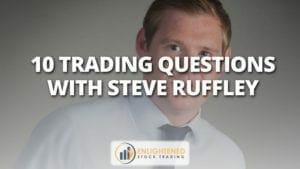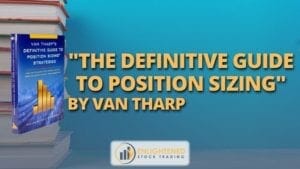We discover what makes great traders tick! My ‘10 Trading Questions With…’ guest this week is Legendary Trading Coach, Van K. Tharp.
Van has had an immense impact on my own trading success as a result of his books and courses. Very early on in my trading career I read ‘Trade Your Way To Financial Freedom’ and it had a profound impact how I viewed trading from that point on. .

One of Van’s later books ‘The Definitive Guide to Position Sizing’ taught me how to manage my risk and optimize my position sizes to meet my trading objectives. I consider these both essential reading for all traders.
I have also undertaken and highly recommend several of Van Tharp’s courses including the ‘Blueprint for Trading Success Workshop’, and home study courses including ‘How to Develop a Winning Trading System that Fits You’; the ‘Peak Performance Course for Investors and Traders’ and ‘Business Planning For Traders and Investors’. Click here for more information on Van Tharp’s courses and products.
I was honoured and excited to be able to interview someone who has had such a profound impact on my trading success…So here we go!
1. How did you first get started trading, and in your business, of modelling good traders and coaching traders?

The Trading Quiz today!
I first started trading in the early 1970’s. I had a $20,000 account while I was in graduate school, and I watched it go to zero in about 6-9 months. But to be fair, in those days your broker charged you 2% commissions to get into a trade and 2% to get out, so you had to make 5% just to make money.
I did it again in 1982. By this time, I had earned my PhD in psychology. When viewing the situation through the lens of a psychologist, I decided that it must be me—something internal, not external, was affecting my trading. This realization started a search for what I was doing wrong. I got involved with what I call the science of modelling, Neuro-linguistic programming (NLP), and started to help others as well as myself. I must admit, I didn’t trade for quite some time, because my passion became transformation, specifically within the context of helping traders.
Currently, I trade a fairly large retirement account for myself and my employees.
2. What was the turning point that really propelled you towards trading success? What’s the turning point for most people?
Deciding my trading results were a function of me was the key to my trading success, and it’s the key for everyone. Once you come to this realization, you to also have to understand these points:
- It takes as much education to succeed in trading as in any other profession; and
- Trading is a business
Then, you have to master certain key principles, which I collectively call Tharp Think. These including thinking in terms of reward-to-risk, understanding that through position sizing that you will meet your objectives, and most of all, mastering yourself.
These concepts are so important they are mentioned in most of the books I have published.
3. Can you talk about objectives?
There are as many objectives as there are traders! For example, you could set objectives like:
- During a one year period, I don’t want a peak–to–trough drawdown bigger than 20%, or
- Over a one year period I want every year to be profitable, or
- I’d like to average 2% gain per month, or
- While I’m willing to accept a peak-to-trough drawdown of 20% at the end of the year, I don’t want to have lost any of my starting equity.
When you think of how many variables there are, and how many combinations of numbers there are, you can see how each trader can have different objectives. After a trader has solidified his or her objectives, the key is to understand that you meet those objectives through position sizing strategies.
All your chosen system does it help make it easier for you to do that. It is not the key to achieving your objectives — that is done through position sizing strategies. Every trader has to master that principle.
4. How do you define a trading mistake, and how to you monitor mistakes?
A trading mistake occurs when you don’t follow your written rules. And, if you don’t have written rules then everything you do is a mistake.
One of my tasks of trading is called a daily debriefing. One aspect of this is for the trader to decide if they have made any mistakes that day and what it cost them in terms of their initial risk, or R.
I require each of my Super Traders keep a mistake log as part of their program, and it’s integral to their success in the program. When students begin, they are about 70-80% efficient. That means 2-3 mistakes every ten trades.
Let’s say your system makes 0.8R per trade. That means that after 10 trades you should be up 8R. But, if you make 2 mistakes each costing 3R, then you are only up 2R. And, a third mistake puts you in the negative.
You’ve turned a good system into a losing system, simply by making mistakes – and most people are never aware that they are doing it.
To become a graduate from the Super Trader program students must complete 100 trades with at least an efficiency of 95%. And it’s not as easy as it may sound.
5. What does it take to find a trading system that fits you and that works?
Well, a trading system that fits you has to work in the market type that you are currently trading.
For example, it’s pretty easy to design a good system for any one market type, but it’s insane to expect it to work in all market types. A system that works great in a bear market would not work the same in a sideways bull market, for example.
Ideally you can trade a system that has an SQN® of 2.5 or better after 100 trades. (SQN is short for System Quality Number®, it’s a measure I developed to rate how well a system performs).
Next, it has to fit your beliefs and your criteria for trading. You don’t trade the market -you trade your beliefs about the market, so the system you pick should be one that fits your beliefs.
Finally, everyone will want to have a set of personal criteria by which a trader could determine a system fits him or her, so it also has to fit that list of criteria as well.
6. What 1-3 trading books should every trader read?
The two musts are the Definitive Guide to Position Sizing Strategies (2nd Ed.) and Trading Beyond the Matrix: The Red Pill for Traders and Investors. Those, in my opinion, are my two most important books.
Then, if I were to pick one book that I didn’t write, it would probably be the original Market Wizards book.
7. If you had 1 minute with someone who wants to learn how to trade in stocks, what would you say?
Understand that the results you get are totally a function of YOU, so you had better get to know yourself. That’s a big task but it’s a task that will change your life forever.
The second part of that is to realize that trading is as much a profession as any other profession. You need the right education to do it correctly. Most people think they can just open up an account and make money by somehow figuring out the right investments. And it’s not that simple at all.
8. What separates the average from the very best traders?
Well, in screening for my Super Trader program, I look for traders who are willing to look at, and work on, themselves. I look for commitment to do the work necessary to succeed. I look for intangibles such as being good at math…. like games and strategizing, NTJ personality on the Myers Briggs scale, if possible. Those are the primary ones. Plus someone should thoroughly understand the answer to question 7, above. Those people have a chance to be great traders.
On the other hand, if you think understanding the market is the key to success, have no interest in discovering your impact on your trading results (because there is always something to blame), or spend all your time looking for a Holy Grail entry system, then you are average at best and will probably lose a lot of money.
9. How should one ensure that their trading will continue to be successful in the future?
The first thing I would recommend is a good “worst case” contingency plan, which could take about 40 hrs of work to thoroughly explore all likely scenarios. During this process, you should have rehearsed solutions to those contingencies that might come up.
Because the market is more creative than most people’s imagination, when they consider what could go wrong, I recommend a daily mental rehearsal in which you think of what could happen to cause you to make a mistake during the trading day. With each potential mistake, then think of a solution or two and rehearse it.
And last, there are at least six market types, Bull, Sideways, and Bear and each could be under Quiet or Volatile conditions.
As I have said before, it is insane to expect one system to work in all market types, so you should either be prepared to be in cash in when something you cannot handle arises, or have a different system for each market type.
10. How do you help traders in your Super Trader Program?
Actually, when I wrote Trading Beyond the Matrix, it was designed to almost be a home study mini-version of the Super Trader program. However, the Super Trader Program is an extensive 4-6 year program, which probably involves about 3,000 hours of work.
After successfully completing the program traders understand the key principles in trading, they clear out all their blocks to success, and really get to know themselves.
They must also develop a business plan for their trading business (this usually requires 150+ pages to do), have at least three systems that fit them, covering all the market conditions, and then be able the trade those systems at least 95% efficiency.
Van Tharp’s Bio:
Dr. Van K. Tharp has been coaching traders since 1982. He has a Ph.D. in Psychology and is an NLP Modeller. The Van Tharp Institute supports trader development through books, home study courses, workshops and a weekly newsletter. The newsletter is free and available at RedPill.VanTharp.com
He has written 11 books, including his Peak Performance Course for Traders and the recently published Trading Beyond the Matrix: The Red Pill For Traders and Investors.
Free book: The first 200 Trading System Life readers that go to RedPill.VanTharp.com and use the coupon code TRADINGSYSTEMLIFE receive a free copy of Trading Beyond The Matrix, softcover edition!
[Editors Note: I highly recommend all of Van Tharp’s products and workshops – they are one of the major reasons my trading is profitable and I have survived in the markets for the last decade. Click here for more information on Van Tharp’s courses and products. – A.R.]
More Trader Interviews:
- 10 Trading Questions With…Ray Barros
- 10 Trading Questions with…Paul King
- 10 Trading Questions with…Malcolm Stacey
- 10 Trading Questions With…Michael Gouvalaris
- 10 Trading Questions With…Steve Ruffley
- 10 Trading Questions with…Van Tharp
- 10 Trading Questions With…Robert Carver
- 10 Trading Questions with…Richard Weissman
- 10 Trading Questions with…Jack Schwager
- 10 Trading Questions With…Adrian Reid








My spouse and I stumbled over here from a different web address and thought
I should check things out. I like what I see
so now i am following you. Look forward to looking into your web page for
a second time.
Thankyou Rundpool – I am glad you are finding it helpful. Please let me know if I can help with your trading in any way!